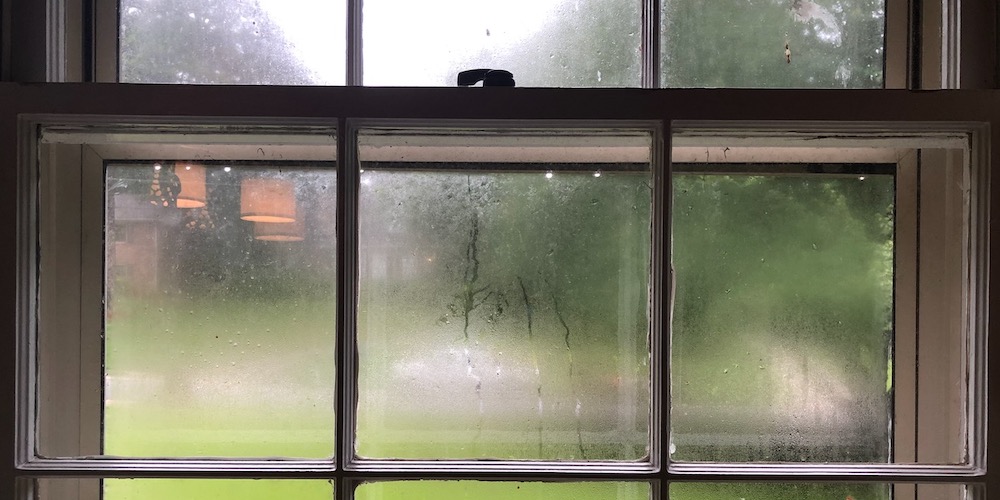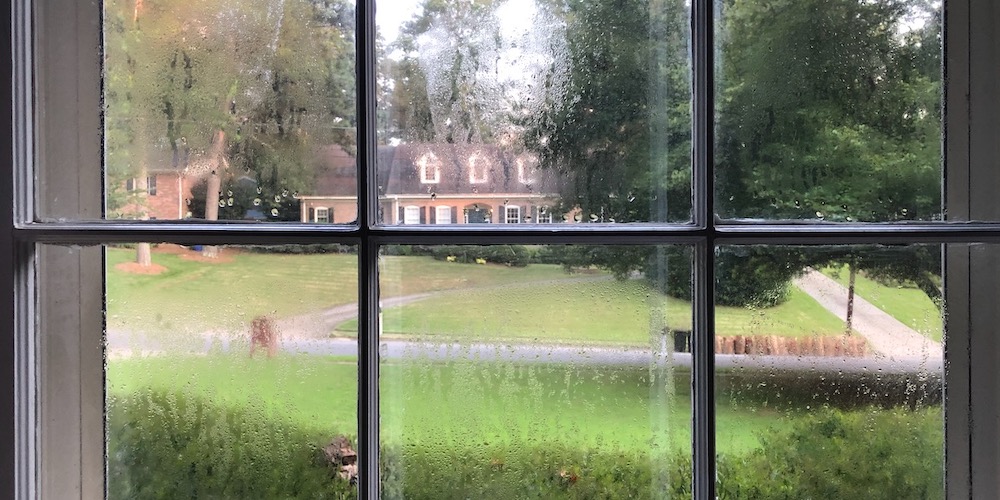Condensation on Storm Windows: A Lesson in Condensing Surfaces

It’s been muggy in Atlanta this week. We’ve had dew point temperatures in the low to mid 70s Fahrenheit. I live in a 60 year old house, so the combination of high humidity and air conditioning can mean condensation. Currently we have the original windows plus the storm windows that someone added in the decades after the house was built. With the humidity and heat we’ve had this week, I’ve seen condensation on storm windows and on the main windows behind them.
Condensation on storm windows
I took the lead photo above first thing in the morning earlier this week. The outdoor temperature was in the low 70s Fahrenheit. The relative humidity was about 100%, which means the dew point and the dry bulb* temperatures were about the same. The condensation was on the outside of the storm window because that was the condensing surface nearest to the saturated air.
We keep our thermostat at 74° F, and the indoor temperature in the living room, where those windows are, was probably a bit lower in the morning, maybe 73° F. That made the temperature inside about the same as the outdoor dry bulb temperature and the dew point. And that gave the storm windows the extra little push they needed to condense water vapor out of the air.
Condensation on main windows
So, in the morning I had condensation on the outer surface of the storm window. When I came home from the office later that day, I took the photo below. There’s still condensation on the window, but now it’s in a different place. It’s on the outer surface of the main window, not the storm window now.

Let’s make this easier by numbering the surfaces 1 through 4, with 1 being the surface I can touch standing inside the house and 4 being the surface I can touch standing outside the house. The morning condensation occurred on surface 4. The evening condensation occurred on surface 2.
Why did the condensing surface move? In the morning, everything was at about the same temperature and the water vapor was outside. In the evening, the outdoor temperature was about 90° F. That would keep surface 4 too warm to be a condensing surface when the dew point is in the 70s Fahrenheit. But the storm windows aren’t airtight so there’s plenty of water vapor between the panes. With our thermostat at 74° F, and outdoor dew points about the same, now surface 2 becomes the condensing surface.
Condensation on storm windows, and behind them on the inner panes of glass, can happen in summer time in humid climates. It’s a regular occurrence in really humid places. When I checked the dew point map of the US yesterday, the highest dew point I saw was in Iowa. It was 84° F. With a dew point that high, even double pane, low-e windows would be susceptible to condensation.
How’re your windows doing?
Allison Bailes of Atlanta, Georgia, is a speaker, writer, building science consultant, and founder of Energy Vanguard. He is also the author of the Energy Vanguard Blog and is writing a book. You can follow him on Twitter at @EnergyVanguard.
* Dry bulb temperature is what we usually just call temperature.
Related Articles
Daniel Boone’s Dew Point Problem
Buried Ducts Risk Condensation in Humid Climates
Make Dew Point Your Friend for Humidity
NOTE: Comments are moderated. Your comment will not appear below until approved.
This Post Has 10 Comments
Comments are closed.

Allison, how many grains per square inch would you estimate are on that window?
Are you sure that you saw an 84 F dewpoint in Iowa on that map? I was there last week and it was humid, but 84 F dewpoint is a crazy high number that I have never seen in the U.S. before.
Roy, if you click on the last link in the Related Articles section, you’ll see that the record dew point for the US is 91° F. That was Melbourne, Florida, not a surprise. Also not a surprise is that New Orleans is tied for second at 90° F. And so is Appleton, Wisconsin. The upper Midwest can get some nasty humidity sometimes.
When I looked at the map, most of Iowas was in the 70s Fahrenheit, but there was one place in north central Iowa that stuck out at 84° F. You must have been in one of the other parts of the state or maybe at a time when it was less humid.
I am still skeptical of that dewpoint map website. I think some of their sensors need calibration. I am guessing that this data is coming from internet-connected home weather stations.
It’s good to be skeptical, Roy. I just went to see if they said anything about where the data come from and noticed that they give the weather station for each entry when you go to the state level. I didn’t look at the state level last week, but the area where that 84° F dew point was showing seems like it might have been Clarion, with weather station KCAV.
I just went back to this website today, and it shows 84 F dewpoint again in Clarion while the surrounding weather stations show 73 – 79 F dewpoints. I believe the 73 F dewpoints, but I am not sure about the 79 F dewpoint either. My only point is that one should be careful when using other people’s data. I doubt that the guy at the airport in Clarion (population 2800) calibrates his sensors too often. Since this station is also showing an 84 F dry-bulb temperature (100% RH), I wouldn’t be surprised if he is using a wet-bulb thermometer for humidity and hasn’t wetted his wick in quite a while.
Ugh, that makes me squirm to get away just in sympathy.
First thought is flee underground, but likely you’ve got heavy clay there and it’s likely fairly wet soil…so no good.
I just read an article on experimental housing raised on stilts, only ten feet or so was adequate, in hot humid places to escape mosquitoes. While that was about insects, it does lead one to wonder about whether there is any substantially useful stratification of humidity, i.e. is there any appreciable difference of condensation on windows on the upper floors?
Daphne, yes, humidity does stratify. I’ve measure significant differences in relative humidity and dew point from the floor to the ridge in encapsulated attics (link below). The water molecule is lighter than nitrogen and oxygen molecules, but I think there’s more to it than that.
Humidity in a Spray Foam Attic
An interesting discussion in your article! The diurnal swings aren’t (or shouldn’t be) surprising, but the degree of stratification within such a short space surprised me. However, as the comments suggest, a great deal of interplay is likely with the roof above. Are you aware of (yes, I will have to pull out my own Google-fu) any studies showing humidity strata in the open air?
Can’t say I really know where I’m going with this topic, really just reaching for a better grasp on understanding conditions before hoping to manipulate them.
Cheers
I have the same issues with the windows that I have not replaced yet in my house. The newer windows are Marvin Elevate which have a fiberglass core that makes for a nice thermal break.
Matt, I’ll be replacing mine, but I’ve got a number of things to do first. All the improvements I have planned are one reason I undersized my mini-split heat pumps. It’ll sure be nice to get to the windows, though.